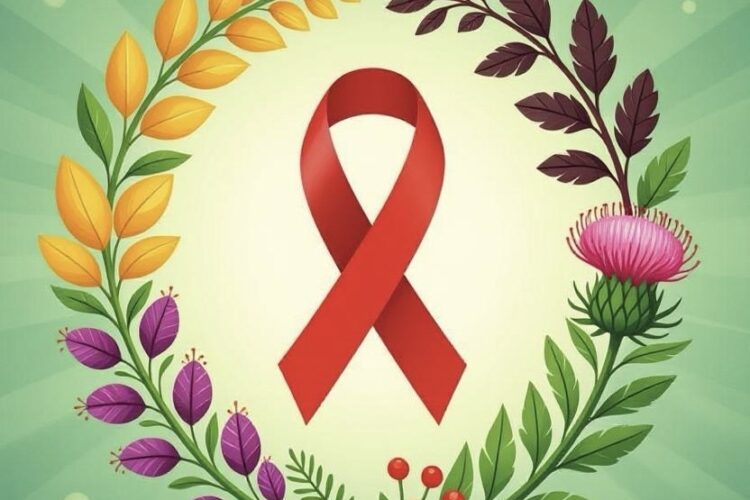Herbal remedies offer complementary support for HIV and AIDS, enhancing immune function and symptom relief alongside antiretroviral therapy (ART) and highly active antiretroviral therapy (HAART). Traditional Chinese Medicine (TCM), like compound SH and Qiankunning, boosts viral suppression and CD4 counts, while herbs like curcumin, andrographolide, and milk thistle show antiviral activity. Capsaicin and SP-303 help manage symptoms, and α-Zam therapy resolves HIV symptoms in weeks. Latency-reversing agents, including PKC agonists and HDAC inhibitors, aid HIV reactivation, with plant-based compounds enhancing effects. However, herbal-drug interactions, like those with St. John’s wort, require careful monitoring. Clinical trials show TCM and herbs improve outcomes but aren’t standalone treatments. Integrating herbal medicines with ART demands oversight to ensure efficacy and safety for people living with HIV.
Long Version
Exploring Herbal Remedies in HIV Management: An In-Depth Overview
Human Immunodeficiency Virus (HIV) and Acquired Immunodeficiency Syndrome (AIDS) remain significant global health challenges, affecting millions of people living with HIV (PLWH). While antiretroviral therapy (ART) and highly active antiretroviral therapy (HAART) have revolutionized treatment outcomes by achieving viral suppression, reducing viral load, and improving CD4 count, many PLWH seek complementary therapies to enhance immune function, manage opportunistic infections, and provide symptom relief. Herbal medicines, rooted in traditional medicine systems like Traditional Chinese Medicine (TCM), offer alternative medicine options through natural products with potential antiviral activity. However, their efficacy, pharmacological mechanisms, side effects, and drug interactions require careful consideration, as evidenced by various clinical trials.
Herbal remedies and herbal treatments serve as complementary therapies for PLWH, often focusing on immune boosting and overall well-being. In regions where access to ART is limited, traditional medicine plays a pivotal role in managing symptoms and supporting treatment adherence. For instance, in Care and Treatment Clinics (CTC) across Africa, studies using the pill count method to assess adherence have shown that concurrent use of herbal medicines with ART can influence viral suppression and CD4 count improvements. These approaches highlight the need for integrated strategies that balance conventional and herbal interventions.
The Role of Traditional Chinese Medicine in HIV Care
Traditional Chinese Medicine (TCM) has been extensively studied for its potential in treating HIV infections and AIDS, emphasizing holistic immune boosting and symptom relief. TCM often employs compound decoctions—mixtures of multiple herbs—to achieve synergistic effects, enhancing antiviral activity and reducing side effects associated with ART. For example, the Chinese herbal compound SH, composed of five herbs, has demonstrated increased antiviral benefits when combined with HAART, leading to better viral suppression and improved immune function in clinical trials. Similarly, Qiankunning, another TCM formulation, has shown promise in reducing viral load and supporting long-term survival among PLWH. These compound decoctions target pharmacological mechanisms such as modulating immune responses and alleviating opportunistic infections, making them valuable for people living with HIV who experience ART-related side effects.
Licorice, a monomeric herbal remedy in TCM, is frequently used as an additive in HIV treatments, promoting immune function and viral suppression. Integrated TCM interventions have also delayed progression to AIDS by improving quality of life and reducing symptoms, with studies indicating enhanced efficacy when combined with HAART. However, herbal-drug interactions remain a concern, as some TCM herbs can alter ART pharmacokinetics, underscoring the importance of monitoring in clinical settings.
Key Plant-Based Compounds and Their Antiviral Mechanisms
Plant-based compounds form the backbone of many herbal treatments, offering diverse antiviral activity against HIV. Curcumin, derived from turmeric, inhibits HIV-1 replication by targeting Tat protein and modulating pathways like PI3K/AKT and JAK/STAT, leading to HIV suppression and reduced inflammation. It also enhances brain delivery of ART drugs, curbing oxidative stress and improving treatment outcomes in PLWH. Andrographolide, from Andrographis paniculata, exhibits broad-spectrum antiviral activity, inhibiting HIV-induced cell cycle dysregulation and boosting CD4 count in phase I trials. Its derivatives further protect against HIV by blocking gp120-mediated cell fusion.
Capsaicin, the active component in chili peppers, shows potential in preventing HIV-1 infection by inhibiting viral transfer and blocking detrimental vascular effects of protease inhibitors like ritonavir. Although ineffective for managing HIV-associated peripheral neuropathy pain, it contributes to overall immune function support. Milk thistle (Silybum marianum), through its silibinin component, reduces cellular activation and blocks HIV-1 infection, while being safe with certain ART regimens like darunavir-ritonavir. However, it can lower levels of indinavir, highlighting herbal-drug interactions.
SP-303, a proanthocyanidin oligomer from Croton lechleri, effectively reduces diarrheal symptoms in AIDS patients, a common opportunistic infection complication. α-Zam therapy, a herbal remedy combining Nigella sativa and honey, has demonstrated efficacy in Nigerian studies, fully resolving HIV symptoms within weeks, increasing CD4 count, and achieving viral suppression without detectable viral load. Its potent anti-HIV activities make it a candidate for further development in HIV management.
Advanced Strategies: Latency-Reversing Agents and HIV Reactivation
Addressing HIV latency is crucial for achieving a functional cure, and latency-reversing agents (LRAs) play a key role in HIV reactivation to expose hidden reservoirs. PKC agonists and HDAC inhibitors (HDACi) are prominent classes, with plant-based compounds enhancing their effects. For instance, natural products from Polygonum cuspidatum promote Tat-dependent HIV latency reversal by triggering P-TEFb release from 7SK snRNP, facilitating transcription elongation. Bet bromodomain inhibitors, often derived from herbal sources, antagonize Brd4 to activate latent HIV, working synergistically with P-TEFb to improve reactivation. These mechanisms underscore the potential of monomeric herbal remedies and compound decoctions in HIV suppression strategies, though clinical trials are needed to confirm long-term efficacy.
Synergistic effects are evident when LRAs like PKC agonists combine with HDACi, amplifying HIV reactivation with minimal cytotoxicity. Herbal integrations, such as those increasing CycT1 levels, allow BET bromodomain inhibitors to release free P-TEFb, recruiting factors for enhanced antiviral activity. This approach holds promise for PLWH, potentially reducing reliance on HAART alone.
Clinical Trials, Efficacy, and Challenges
Clinical trials have provided mixed but insightful data on herbal medicines for HIV. TCM combined with HAART improves immune function, prolongs survival, and enhances quality of life, with studies in Guangxi showing better CD4 count gains in patients with low baselines. However, overall evidence remains insufficient to fully endorse herbal treatments as standalone options, emphasizing their role in complementary therapies.
Efficacy varies; herbs like garlic and Moringa oleifera are commonly used in CTC settings, but interactions with ART can affect adherence measured via pill count methods. Side effects, such as altered drug clearance from milk thistle’s impact on UGT1A, necessitate caution. Drug interactions, including those with St. John’s wort reducing ART effectiveness, highlight risks.
In conclusion, while herbal medicines offer valuable insights into immune boosting and symptom relief for PLWH, their integration with ART and HAART demands rigorous monitoring of viral load, CD4 count, and treatment outcomes. Ongoing clinical trials will refine these approaches, potentially unlocking more effective, synergistic strategies against HIV and AIDS.
Hashtags For Social Media
#HIVHerbs #NaturalHIVRemedies #HerbalHIVTreatment #HIVNaturalCure #AIDSHerbalSupport #ImmuneBoostHerbs #ViralLoadReduction #CD4CountBoost #TCMforHIV #TraditionalChineseMedicine #CurcuminHIV #AndrographolideBenefits #MilkThistleHIV #CapsaicinHealth #AlphaZamTherapy #LatencyReversingAgents #HDACInhibitors #PKCAgonists #HIVSymptomRelief #OpportunisticInfections #ARTComplementary #HAARTSupport #PlantBasedAntivirals #HIVImmuneFunction #HerbalDrugInteractions #HIVClinicalTrials #NaturalAntiviralHerbs #HIVWellness #AlternativeMedicineHIV #HIVAwarenessHerbs
Related Questions, Words, Phrases
hiv herbs | what are natural herbs for hiv | best herbal remedies for hiv treatment | hiv herbal medicine options | can herbs cure hiv | traditional herbs used for hiv | herbal supplements for hiv patients | natural ways to manage hiv with herbs | herbs that boost immunity in hiv | african herbs for hiv | chinese herbs for hiv and aids | hiv herbs side effects | effective herbal treatments for hiv symptoms | herbs to reduce hiv viral load | natural antiviral herbs against hiv | hiv and herbal drug interactions | herbs for hiv opportunistic infections | ayurvedic herbs for hiv management | home remedies herbs for hiv | scientific evidence on hiv herbs | top herbs for cd4 count in hiv | herbal teas for hiv relief | herbs that support art in hiv | natural plant extracts for hiv | hiv herbs research studies | safe herbs for people with hiv | herbal formulas for hiv in tcm | herbs to prevent hiv progression | natural immune boosters herbs for hiv | hiv herbs dosage and usage | alternative medicine herbs for aids | herbs for hiv neuropathy pain | global herbs used in hiv care | herbs that inhibit hiv replication | natural herbs for hiv symptom relief






